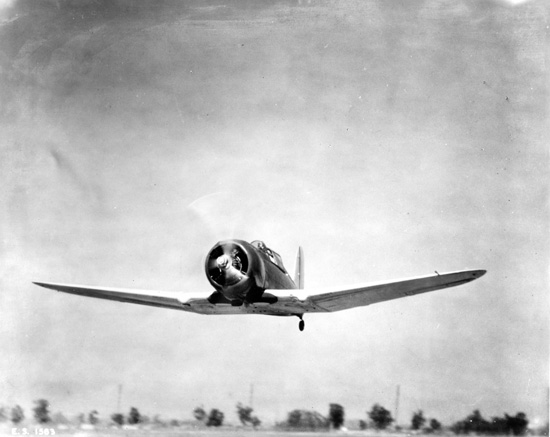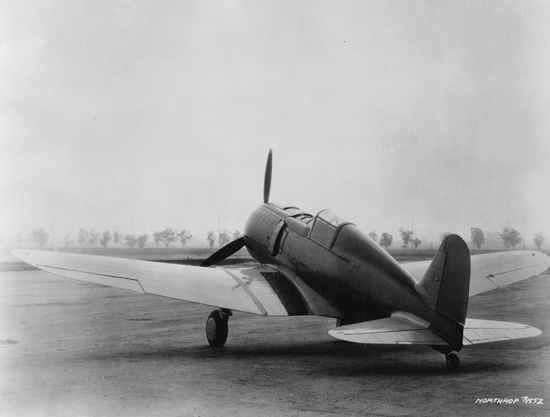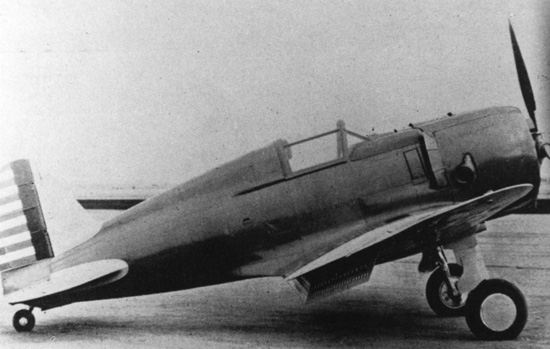
|
 |
The Northrop 3A |
 |
 |
 |
 |
 |
|---|---|---|---|---|---|---|---|
 |
 |
 |
 |
 |
|||
 |
||
|
The Northrop 3A | ||
|
In 1935 as aircraft technology was rapidly advancing, the United States Army Air Corps (USAAC) was looking to replace its mainstay fighter, the Boeing P-26 Peashooter. The Peashooter was considered an interim fighter and had been conservative in design with external wing bracing and fixed landing gear. New designs were now being sought after to usher in a completely new era of the American fighter. New concepts included all-metal construction, enclosed cockpits, retractable landing gear, hydraulic systems and more powerful engines. The USAAC called for a competition and designs were submitted by Curtiss, Seversky and Northrop for a fly-off on June 18, 1935.1
Completed in July 1935, Northrop submitted the A3 (XP-948, c/n 44), which was based on the design of the Northrop XFT. It which was a low-wing all-metal semi-monocoque monoplane with fully-retractable main landing gear, an enclosed cockpit and powered by a Pratt & Whitney 700 hp (522 kW), SR-1535-6 Twin Wasp Junior engine, driving a three-blade propeller. It was unarmed but had provisions for the standard armament for the time, which consisted of one .30 caliber and one .50 caliber machine guns in the fuselage. |
| Seversky had originally entered SEV-2XD, which was a two-seat, fixed-gear fighter, but after eyeing the Curtiss Model 75 and Northrop 3A, it changed to the single-seat SEV-1XP. Both the Northrop and Curtiss planes had retractable landing gear, which Seversky realized put it at an extreme disadvantage. The switch was allowed, because Seversky’s first entry was badly damaged, after crashing into the sea (perhaps deliberately), on the way to the Wright Field for the competition. This drew protests from Curtiss, but the fly-off was postponed until April 1936. |
|
As it turned out, Seversky won the competition, which was developed as the Seversky P-35. The Curtiss plane was powered by a derated version of the 1,050-hp (783-kW)
Pratt & Whitney R-1830-13 Twin Wasp engine for test and evaluation under the designation Y1P-36. Curtiss was awarded a contract for three examples of the Y1P-36, which developed into the Curtiss P-36.2
The Northrop 3A was briefly tested at Wright Field where it was found to be somewhat unstable and prone to spinning and was returned to Northrop for modifications. During tests over the Pacific on July 30, 1935, piloted by First Lieutenant Frank Scare, the airplane failed to return to base. No trace of the aircraft or pilot was ever found. The design of the Model 3A was subsequently sold to Chance Vought Aircraft which was further developed as the V-141. |

|

|

|
| Specifications: | |
|---|---|
| Northrop Model 3A | |
| Dimensions: | |
| Wing span: | 34 ft 6 in (10.21 m) |
| Length: | 22 ft 3 in (7.78 m) |
| Height: | 9 ft 1 in (2.77 m) |
| Weights: | |
| Operational: | 3,900 lb (1,769 kg) |
| Performance: | |
| Maximum Speed: | 270 mph (434 km/h) |
| Powerplant: | |
| One 700 hp (592 kW) Pratt & Whitney SR-1535-6 Twin Wasp Junior engine. | |
| Armament: | |
| One .30 caliber and one .50 caliber fuselage mounted machine-guns. | |
| Endnotes |
|---|
|
1. David Mondey. American Aircraft of World War II. New York: Smithmark Publishers, 1996. 213. 2. Peter M. Bowers. Aircraft In Profile, Volume 4, The Curtiss Model 75. Surrey, England: Profile Publications Ltd., 1970. 4. |
© Larry Dwyer. The Aviation History Online Museum.
All rights reserved.
Created February 10, 2013. Updated November 20, 2014.